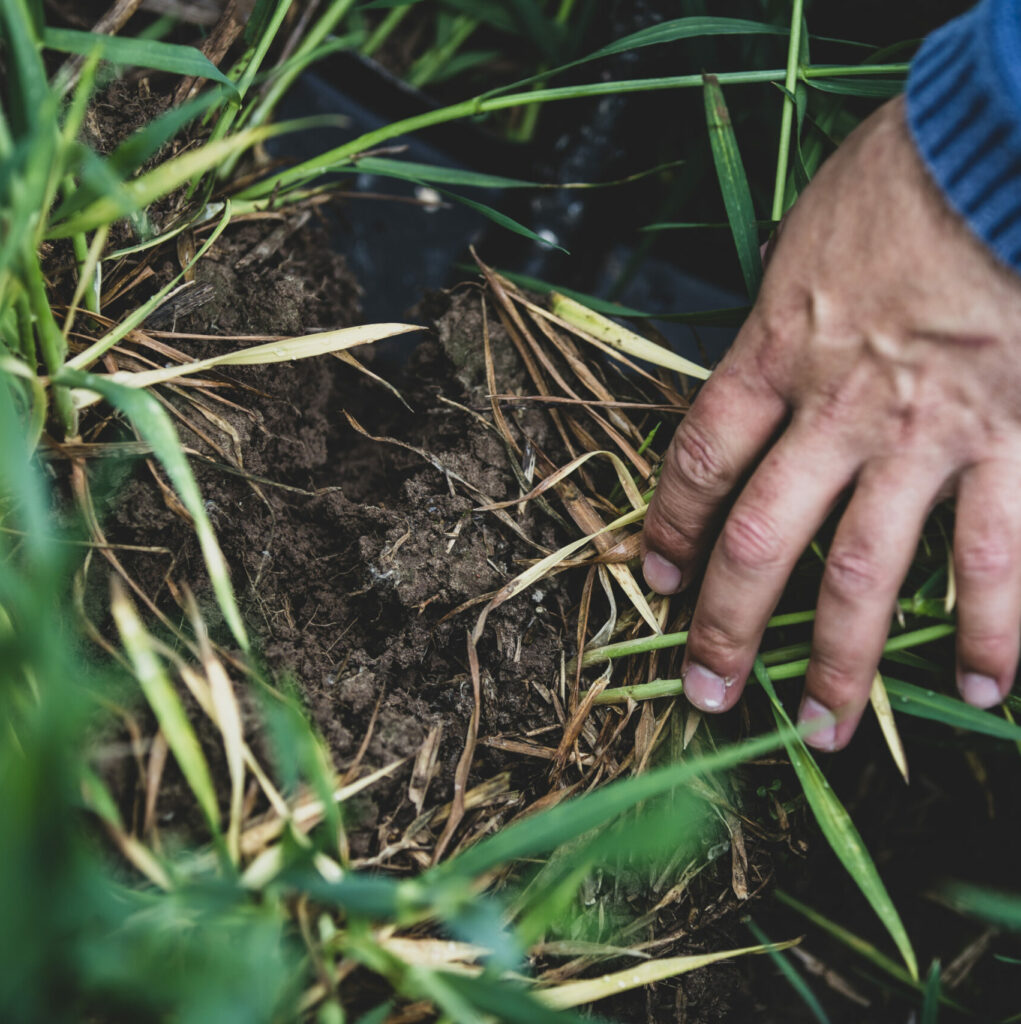
Healthy soil curbs erosion and
yields better harvests
Soil degradation and erosion are common challenges on farms across Europe, and are commonly linked to agricultural practices. When fertile topsoil is lacking, the risk of nutrient loading to nearby water bodies increases. Therefore, implementing practices that ensure good soil health is one of the most vital actions farmers can take to reduce agriculture’s negative impact on water quality—and enhance the productivity of their land in the process.
What is “healthy” soil?
Soil refers to a critical part of the ecosystem located in the uppermost layer where plants grow. It hosts 25% of the world biodiversity, stores around two times the carbon found in the atmosphere and three times the amount found in vegetation, as well as directly or indirectly produces about 95% of our food.
Healthy, well-functioning soil has a porous structure and a good capacity for receiving and storing water, which means it tolerates both drought and excessive rainfall better. Healthy soil also has rich organic content and enables plant growth and high nutrient uptake by plants. All in all, these characteristics lead to reduced nutrient losses, better protection against run-off and erosion, and higher yields
On the other hand, if soil lacks any of the above functions, the risk of erosion and the leaching of nutrients and sediments to nearby water bodies increases. However, by implementing the practices listed below, soil degradation can be mitigated—and compromised soil can even recover. An important key to success when implementing these practices is for farmers to familiarize themselves with the unique properties of their soil, including variations across different plots.

Farming practices for healthy soil

Protect and recover soil structure
Soil compaction means the degradation of soil structure. Compaction adversely affects the air capacity, permeability, and water retention of soil. It reduces root development and biological activity and leads to decreased crop yields.
Reducing wheel loads by using lighter machinery, adding more wheels or upgrading to lower-pressure tires can help reduce risk of compaction. Careful timing of work done on fields is also important—soil should be dry enough, as working on wet soil increases the risk of compaction.
Crop rotation can also be employed to protect soil structure. Moving away from vulnerable monocultures and, instead, diversifying and sequentially planting different crops with different root depths on the same plot of land brings a lot benefits. In addition to improving soil health, it optimizes the nutrients in the soil (for example through nitrogen-fixing plants) and can help combat pests and weeds. The rotation can include three to five different crops, or even more.
Employing reduced tillage or no-till methods can also help to recover soil structure. In the case where soil compaction has already occurred, and a low yielding field needs to be recovered, subsoiling can aid in loosening compacted subsoil horizons. It helps to improve soil infiltration capacity and root penetration. Deep-rooted renovation plants can also be used to recover degraded soil structure.
FARM STORY: Taking a chance on strip-till to revitalize over-plowed land
Add organic matter to the soil
The ideal soil composition is 25% air, 25% water and 50% solid matter, of which some 5-15% is organic matter. Having more organic matter in the soil contributes to improved soil health and production capacity. The accumulation of organic matter promotes enhanced nutrient cycling, reduces compaction and facilitates better formation of soil aggregates (pieces of soil).
Furthermore, organic matter increases biological activity and supplies soil with a reservoir of slowly releasing nutrients. Soil microorganisms such as fungi and bacteria, as well as earthworms, decompose organic matter. High biological activity in the soil improves soil structure. It also helps to mitigate climate change by fixing carbon in the soil.
Far from ideal, the long-term loss of organic matter from agricultural soils has been reported on cultivated fields in different parts of Europe. Growing catch crops or intercrops, and mechanically adding dry cattle manure or compost are a few ways to incorporate more organic matter into the soil.
FARM STORY: MAINTAINING HEALTHY SOIL IS CENTRAL TO THIS FARM TO CURB RUNOFF AND BOOST HARVESTS


Keep the soil covered
On agricultural land, the highest rates of erosion occur in crop systems where soil is left bare for extended periods. Maintaining year-round plant cover protects the soil against erosion and reduces runoff of phosphorus bound to soil particles. When there is more rain than the soil can infiltrate, cover crops can help keep soil particles anchored in place. They also help to maintain organic matter in the soil and improve soil structure and microbiological activity.
Year-round plant cover can mean permanent or perennial grasslands or perennial horticulture plants, for example. Permanent plant cover, such as permanent grassland, also tends to accumulate organic matter in the soil and thus, also has a positive climate effect. Plant cover over the winter also helps wildlife to survive. It is particularly important for birds in an agricultural environment.
The timespan of plant coverage can be extended by using winter crops or maintaining annual grassland over the winter—or by using catch crops or intercrops. Catch crops and intercrops bind to the nutrients that have not been used by the main crops and are released from the soil after harvest. Sown together with the main crop or after the harvest, they are left to be buried in the soil, or to serve as plant cover over the winter. This not only helps maintain organic matter in the soil, but also helps reduce nitrogen leakage by absorbing nitrogen and then releasing it for the benefit of the next crops.
FARM STORY: Success came when these farmers made a healthy soil ecosystem their top priority
Control erosion
Controlling erosion on fields prone to erosion or flooding is vital to preventing nutrient loss. Buffer zones, strips of perennial vegetation or shelter belts along major ditches, riversides, and lakes helps to reduce erosion and prevent the transport of nutrients and plant protection products to water bodies. Broad buffer zones are especially useful on fields located alongside water bodies that slope, or regularly become flooded or water-logged.
Maintaining grasslands and other vegetation in riparian zones brings the added benefit of enhancing biodiversity and supporting wildlife. Planting trees and shrubs on riparian buffer zones can help further limit erosion, with the roots helping keep soil in place and protect the fields from wind or windbreaks, while also enhancing biodiversity and supporting wildlife in the area.
FARM STORY:Award-winning methods to protect waters, enhance biodiversity and yield better products

Last modified 13/01/22
